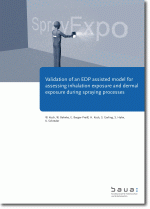- Project number: F 2137
- Institution: Fraunhofer Gesellschaft / Saticon GmbH
- Status: Completed Project
Description:
Within the framework of project F1702 'workplace exposure during the use biocidal products - part 1: inhalation and dermal exposure data on the spraying of liquid biocidal products' a mechanistic model (SprayExpo) for the assessment of inhalation and dermal exposure has been developed. Main area of its application is the authorisation of biocidal products and the evaluation of new and existing substances respectively. The model is based on a simulation of the motion of released droplets taking into account gravitational settling, turbulent mixing with the surrounding air, and droplet evaporation. In the model continuous spatial release patterns can be simulated. No artificial distribution volumes need to be defined. The main input parameters are: the released droplet spectrum, the release rate, the concentration of the active substance, the spatial and temporal pattern of the release process (surface spraying against floor, ceiling, wall; room spraying), the vapour pressure of the liquid, the size of the room and the ventilation rate. While the SprayExpo-model has been validated (to a limited extent) for room spraying scenarios, no validation results are available for surface treatment scenarios. Within the framework of the proposed project it is intended to perform a sufficient number of workplace measurements under variation of important parameters (e.g. spraying distance, spraying pressure etc.) These measured data will be compared with the model predictions by using probabilistic methods.
The project is aimed at a description of the reliability of SprayExpo with respect to the high requirements of the authorization and evaluation procedure. The comparison with measured data will make clear the limits of reliability of the model predictions and of the corresponding risk evaluation. This will enhance the legal certainty of the authorization and evaluation procedures. Occupational safety will be enhanced at the same time, since safety measure for spray application tasks can be addressed more clearly. A validated model will also reduce the necessity of workplace measurements. In addition it is expected that the research results will support the development of further models suited for the assessment of spray exposures. This is also true for the few models that aim at the assessment of dermal exposure. Currently these models are not very evolved and hence there is a considerably lack of information about their reliability and validity respectively.
